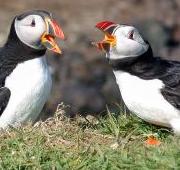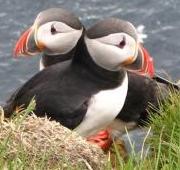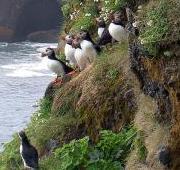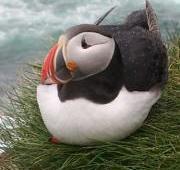 The puffin is a small black and white bird that has a distinctive, colourful orange beak. Puffins are found in coastal regions of the Northern Hemisphere. The puffin is also found in the colder Arctic Circle.
The puffin is a small black and white bird that has a distinctive, colourful orange beak. Puffins are found in coastal regions of the Northern Hemisphere. The puffin is also found in the colder Arctic Circle. A puffin tends to grow from 40cm to nearly 1m in height depending on the species. Some species of puffin, like those puffin that inhabit the Scottish west coast, are much smaller with these Scottish puffin standing at just 30 cm tall.
A puffin tends to grow from 40cm to nearly 1m in height depending on the species. Some species of puffin, like those puffin that inhabit the Scottish west coast, are much smaller with these Scottish puffin standing at just 30 cm tall.


Puffins can dive into the freezing waters and be submerged for up to 30 seconds when they are hunting for food. Although the puffin is an omnivorous bird, the puffin has a primarily carnivorous diet hunting fish, squid, molluscs, crustaceans and small invertebrates. The puffin dives into the water to get it's food before taking it back to a safe place on land where the puffin can eat it. Puffins are known to be able to carry up to a dozen fish in their small beaks at a time.
Due to their small relatively small size, puffins are preyed upon by a number of larger predators but due to the puffins speed and cliff top existence, the puffin is not an easy meal to catch. The main predators of the puffin are large birds such as gulls, hawks and eagles and foxes that primarily eat the puffin's eggs. Humans hunt puffins for their meat, and in Iceland puffin hunting is a very traditional art form.
Puffins mate for life meaning that they only have one partner. The female puffin lays a single egg nearly every year which both the female puffin and the male puffin help to incubate. After an incubation period of around 6 weeks, the puffin chick hatches out of the egg and is reared by both the female puffin and male puffin until it is nearly 2 months old.
Many people believe that puffin chicks are abandoned by their puffin parents when they reach this age, but this is in fact untrue. When the puffin chick is strong enough and able to hunt for itself, the puffin chick will either swim or fly out to sea.
Puffins are not considered to be an endangered species although the puffin populations are threatened by habitat change such as pollution. Oil spills from large tankers are one of the most dangerous pollutants to puffins as they become stuck in the thick oil and become covered in it and so are unable to fly or swim.
Puffins live for an average of 25 years in the wild mainly due to the fact that they nest on high cliffs and are therefore less vulnerable to being preyed upon by mammals on land. Puffins are known to live for longer though and it is not uncommon to be 30 years old.

